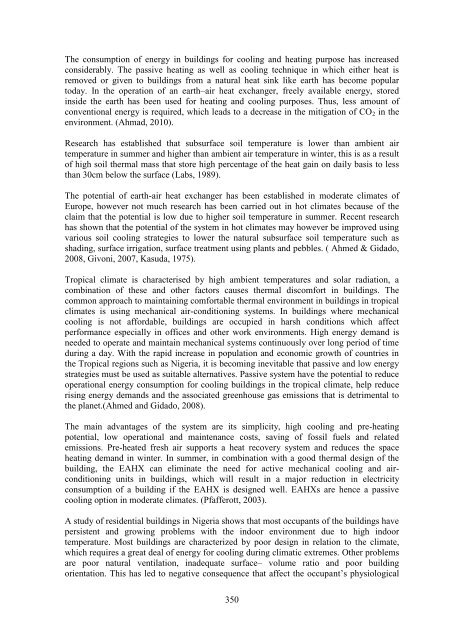Potential of using EAHX for Low Energy Cooling in Nigeria
Potential of using EAHX for Low Energy Cooling in Nigeria
Potential of using EAHX for Low Energy Cooling in Nigeria
You also want an ePaper? Increase the reach of your titles
YUMPU automatically turns print PDFs into web optimized ePapers that Google loves.
The consumption <strong>of</strong> energy <strong>in</strong> build<strong>in</strong>gs <strong>for</strong> cool<strong>in</strong>g and heat<strong>in</strong>g purpose has <strong>in</strong>creased<br />
considerably. The passive heat<strong>in</strong>g as well as cool<strong>in</strong>g technique <strong>in</strong> which either heat is<br />
removed or given to build<strong>in</strong>gs from a natural heat s<strong>in</strong>k like earth has become popular<br />
today. In the operation <strong>of</strong> an earth–air heat exchanger, freely available energy, stored<br />
<strong>in</strong>side the earth has been used <strong>for</strong> heat<strong>in</strong>g and cool<strong>in</strong>g purposes. Thus, less amount <strong>of</strong><br />
conventional energy is required, which leads to a decrease <strong>in</strong> the mitigation <strong>of</strong> CO2 <strong>in</strong> the<br />
environment. (Ahmad, 2010).<br />
Research has established that subsurface soil temperature is lower than ambient air<br />
temperature <strong>in</strong> summer and higher than ambient air temperature <strong>in</strong> w<strong>in</strong>ter, this is as a result<br />
<strong>of</strong> high soil thermal mass that store high percentage <strong>of</strong> the heat ga<strong>in</strong> on daily basis to less<br />
than 30cm below the surface (Labs, 1989).<br />
The potential <strong>of</strong> earth-air heat exchanger has been established <strong>in</strong> moderate climates <strong>of</strong><br />
Europe, however not much research has been carried out <strong>in</strong> hot climates because <strong>of</strong> the<br />
claim that the potential is low due to higher soil temperature <strong>in</strong> summer. Recent research<br />
has shown that the potential <strong>of</strong> the system <strong>in</strong> hot climates may however be improved <strong>us<strong>in</strong>g</strong><br />
various soil cool<strong>in</strong>g strategies to lower the natural subsurface soil temperature such as<br />
shad<strong>in</strong>g, surface irrigation, surface treatment <strong>us<strong>in</strong>g</strong> plants and pebbles. ( Ahmed & Gidado,<br />
2008, Givoni, 2007, Kasuda, 1975).<br />
Tropical climate is characterised by high ambient temperatures and solar radiation, a<br />
comb<strong>in</strong>ation <strong>of</strong> these and other factors causes thermal discom<strong>for</strong>t <strong>in</strong> build<strong>in</strong>gs. The<br />
common approach to ma<strong>in</strong>ta<strong>in</strong><strong>in</strong>g com<strong>for</strong>table thermal environment <strong>in</strong> build<strong>in</strong>gs <strong>in</strong> tropical<br />
climates is <strong>us<strong>in</strong>g</strong> mechanical air-condition<strong>in</strong>g systems. In build<strong>in</strong>gs where mechanical<br />
cool<strong>in</strong>g is not af<strong>for</strong>dable, build<strong>in</strong>gs are occupied <strong>in</strong> harsh conditions which affect<br />
per<strong>for</strong>mance especially <strong>in</strong> <strong>of</strong>fices and other work environments. High energy demand is<br />
needed to operate and ma<strong>in</strong>ta<strong>in</strong> mechanical systems cont<strong>in</strong>uously over long period <strong>of</strong> time<br />
dur<strong>in</strong>g a day. With the rapid <strong>in</strong>crease <strong>in</strong> population and economic growth <strong>of</strong> countries <strong>in</strong><br />
the Tropical regions such as <strong>Nigeria</strong>, it is becom<strong>in</strong>g <strong>in</strong>evitable that passive and low energy<br />
strategies must be used as suitable alternatives. Passive system have the potential to reduce<br />
operational energy consumption <strong>for</strong> cool<strong>in</strong>g build<strong>in</strong>gs <strong>in</strong> the tropical climate, help reduce<br />
ris<strong>in</strong>g energy demands and the associated greenhouse gas emissions that is detrimental to<br />
the planet.(Ahmed and Gidado, 2008).<br />
The ma<strong>in</strong> advantages <strong>of</strong> the system are its simplicity, high cool<strong>in</strong>g and pre-heat<strong>in</strong>g<br />
potential, low operational and ma<strong>in</strong>tenance costs, sav<strong>in</strong>g <strong>of</strong> fossil fuels and related<br />
emissions. Pre-heated fresh air supports a heat recovery system and reduces the space<br />
heat<strong>in</strong>g demand <strong>in</strong> w<strong>in</strong>ter. In summer, <strong>in</strong> comb<strong>in</strong>ation with a good thermal design <strong>of</strong> the<br />
build<strong>in</strong>g, the <strong>EAHX</strong> can elim<strong>in</strong>ate the need <strong>for</strong> active mechanical cool<strong>in</strong>g and aircondition<strong>in</strong>g<br />
units <strong>in</strong> build<strong>in</strong>gs, which will result <strong>in</strong> a major reduction <strong>in</strong> electricity<br />
consumption <strong>of</strong> a build<strong>in</strong>g if the <strong>EAHX</strong> is designed well. <strong>EAHX</strong>s are hence a passive<br />
cool<strong>in</strong>g option <strong>in</strong> moderate climates. (Pfafferott, 2003).<br />
A study <strong>of</strong> residential build<strong>in</strong>gs <strong>in</strong> <strong>Nigeria</strong> shows that most occupants <strong>of</strong> the build<strong>in</strong>gs have<br />
persistent and grow<strong>in</strong>g problems with the <strong>in</strong>door environment due to high <strong>in</strong>door<br />
temperature. Most build<strong>in</strong>gs are characterized by poor design <strong>in</strong> relation to the climate,<br />
which requires a great deal <strong>of</strong> energy <strong>for</strong> cool<strong>in</strong>g dur<strong>in</strong>g climatic extremes. Other problems<br />
are poor natural ventilation, <strong>in</strong>adequate surface– volume ratio and poor build<strong>in</strong>g<br />
orientation. This has led to negative consequence that affect the occupant’s physiological<br />
350
















